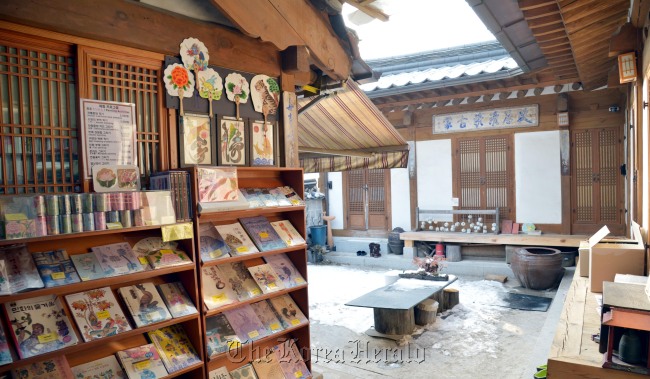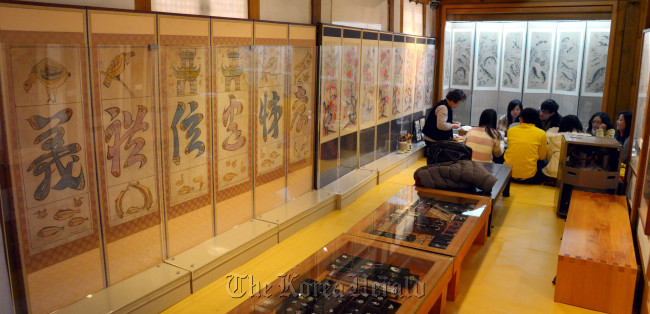The paintings of the people
Do as the commoners did at the Gahoe Minhwa Museum
By Korea HeraldPublished : Jan. 15, 2013 - 19:29
Following is part of a series exploring unique museums, collections and the passionate collectors behind them. ― Ed.
Oftentimes when the general public thinks about paintings, it is the talented and visionary artists behind each work that come to mind. On the other hand, with folk art, the distinction is less about aesthetic expressions and more about its decorative purposes. However, with Korean traditional folk painting, known as “minhwa,” there are deep historical roots that encompass their meanings and intent.
With minhwa literally meaning “painting of the people,” what sets them apart is that they are not known as the creation of renowned masters of art.
“Minhwa are not created by famous artists, rather they are known for being done by your average person, hence their name,” said Hwang Eun-kyung, curator at the Gahoe Minhwa Museum.
Minhwa were painted for decorative purposes for both royals and commoners during the Joseon period. These paintings, which were often done on cloth, paper or silk that is stretched across folding screen canvases, reflected the lives, thoughts and expressions of ordinary people and featured symbols of wealth, happiness and health, as well as the struggles of everyday life.
Oftentimes when the general public thinks about paintings, it is the talented and visionary artists behind each work that come to mind. On the other hand, with folk art, the distinction is less about aesthetic expressions and more about its decorative purposes. However, with Korean traditional folk painting, known as “minhwa,” there are deep historical roots that encompass their meanings and intent.
With minhwa literally meaning “painting of the people,” what sets them apart is that they are not known as the creation of renowned masters of art.
“Minhwa are not created by famous artists, rather they are known for being done by your average person, hence their name,” said Hwang Eun-kyung, curator at the Gahoe Minhwa Museum.
Minhwa were painted for decorative purposes for both royals and commoners during the Joseon period. These paintings, which were often done on cloth, paper or silk that is stretched across folding screen canvases, reflected the lives, thoughts and expressions of ordinary people and featured symbols of wealth, happiness and health, as well as the struggles of everyday life.

Many of these paintings include depictions of mythological creatures, various animal figures and nature. The most common scenes include tigers, fish, birds, flowers and mountain ranges. Minhwa were frequently used for superstitious purposes in the hope of bringing virtue and protecting a family and household from evil spirits.
“Tigers are symbolic in China and Japan as well as in Korea. In our country, tigers are depicted with a smile on their face,” she said.
Tigers are seen as creatures that help get rid of evil ghosts, and although the animal was seen as a powerful creature and a threat to commoners during the Joseon period, tigers were depicted smiling or with a humorous expression in folk paintings. It was a widespread belief that having artwork of the animal would spiritually protect one’s household from disease and bad fortune.
“Fish are also seen in many minhwa paintings,” said Hwang. “Not only do fish sleep with their eyes open, so they were seen as a sign of protection and safety, but they also lay many eggs when giving birth so they were often used as a symbol of fertility.”
A majority of the paintings were painted on a folding screen for the purposes of decorating houses, weddings, birthdays and religious ceremonies. The paintings are simple in nature, non-abstract, yet each panel is its own expression of creativity and freedom.

The Gahoe Minhwa Museum first opened its doors in 2002 and has varying displays of authentic, folding screens of Korean folk art paintings. From Chinese character paintings which express the eight characters of filial piety ― respect, loyalty, faithfulness, obligation, justice, honor and disgrace ― to a large panel painting of bookshelves, representing the sign of scholarly hope, each display at the museum has a unique story behind the art.
The exhibitions in this quaint museum are both artistic and decorative minhwa, some of which are simple and plain, while others are lively and vividly colorful. And aside from the aged cloth, some of the paintings have a New Age essence to them, despite being hundreds of years old.
“Even though all of these paintings are from the Joseon era, many people comment on how modern they look,” she said.
The museum also offers hands-on classes where visitors express creativity by painting their very own minhwa on paper or on small, handheld fans. While minhwa are still being painted to this day, many folding screen canvases are being digitally manufactured using the technological advances of today, rather than painted, depreciating the traditional and historical value of this art form.
“Nowadays when you see minhwa, many of them are just pictures that have been printed,” said Hwang. “If you come here, you can see the orginal paintings, as they were meant to be.”
■ Gahoe Minhwa Museum
(02-741-0466)
● Location: 11-103 Gahoe-dong, Jongno-gu, Seoul
● Hours: Open Tuesday through Sunday from 10 a.m. to 6 p.m.
● Admission: 3,000 won for adults and 2,000 won for students (high school and below)
For more information, visit http://www.gahoemuseum.org
By Julie Jackson (juliejackson@heraldcorp.com)
-
Articles by Korea Herald



![[Exclusive] Korean military set to ban iPhones over 'security' concerns](http://res.heraldm.com/phpwas/restmb_idxmake.php?idx=644&simg=/content/image/2024/04/23/20240423050599_0.jpg&u=20240423183955)

![[Graphic News] 77% of young Koreans still financially dependent](http://res.heraldm.com/phpwas/restmb_idxmake.php?idx=644&simg=/content/image/2024/04/22/20240422050762_0.gif&u=)



![[Pressure points] Leggings in public: Fashion statement or social faux pas?](http://res.heraldm.com/phpwas/restmb_idxmake.php?idx=644&simg=/content/image/2024/04/23/20240423050669_0.jpg&u=)










